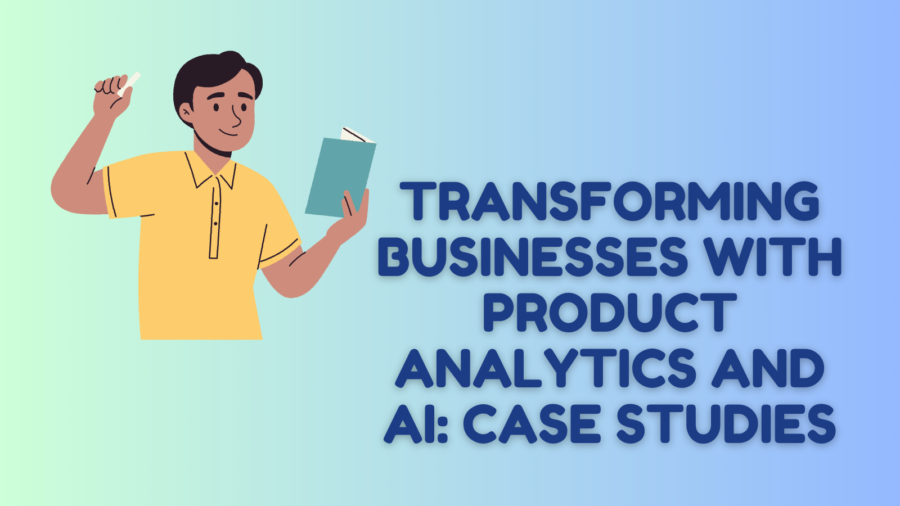Introduction
The strategic use of product analytics and artificial intelligence (AI) has become a game-changer for companies aiming to improve their products and customer experiences. By tapping into valuable insights derived from data, businesses can make informed decisions and create products that meet their customers’ needs more effectively. In this comprehensive article, we’ll explore a collection of diverse case studies that showcase how companies across various industries utilize product analytics and AI to innovate and enhance their offerings.
1. Netflix
The global streaming giant, Netflix has revolutionized the entertainment industry by embracing cutting-edge technologies like Product Analytics and Artificial Intelligence (AI) to enhance the user experience. At the heart of Netflix’s success is its ability to deliver personalized content recommendations, a feat achieved through a sophisticated integration of Product Analytics and AI. By analyzing vast amounts of user data, Netflix can understand individual viewing preferences, behaviors, and patterns, enabling the platform to offer a tailored content catalog to each subscriber. This case study delves into how Netflix’s strategic use of Product Analytics and AI has transformed how users engage with the platform and contributed significantly to customer retention and the company’s overall market leadership.
Implementation of AI Algorithms: Netflix employs advanced AI algorithms to analyze user data, considering factors such as viewing history, genre preferences, time of day, and even how users interact with the platform. The recommendation engine, powered by machine learning models, continuously refines its predictions, learning from user feedback and evolving preferences. This dynamic approach allows Netflix to stay ahead in the highly competitive streaming landscape, ensuring that users are consistently presented with content that aligns with their tastes. As a result, subscribers spend more time on the platform, increasing customer satisfaction and loyalty.
Impact on Business and User Engagement: The strategic marriage of Product Analytics and AI at Netflix has yielded tangible business results. The platform’s ability to recommend content that resonates with individual users has significantly increased viewer engagement. Longer watch times contribute to higher subscription retention rates and provide Netflix with valuable data for content production and acquisition strategies. This data-driven approach has enabled Netflix to optimize its content library, ensuring that it invests in producing or licensing content that aligns with the evolving preferences of its diverse user base. Ultimately, Netflix’s success in leveraging Product Analytics and AI exemplifies how a data-driven, personalized approach can redefine the entertainment industry’s landscape and secure a lasting competitive edge in the ever-evolving digital era.
2. Spotify
Spotify, the renowned music streaming platform, has revolutionized how people consume music globally. Central to their success is the strategic integration of Product Analytics and Artificial Intelligence (AI) to enhance user experience and deliver personalized content. With millions of active users and an extensive library of songs, podcasts, and playlists, Spotify relies on robust analytics to understand user behavior, preferences, and engagement patterns. By leveraging AI, Spotify takes these insights to the next level, tailoring recommendations and playlists to each user’s unique taste. This case study delves into how Spotify harnesses the power of product analytics and AI to maintain its position as a competitive leader in the music streaming industry.
Implementing AI for Personalized Recommendations: Spotify’s success in delivering personalized music recommendations can be attributed to its sophisticated AI algorithms. The platform employs machine learning models that analyze user listening habits, preferences, and historical data to create customized playlists and discover weekly recommendations and daily mixes. The algorithms continuously learn and adapt based on user interactions, ensuring that recommendations become increasingly accurate. This personalized approach keeps users engaged and contributes to user retention, as listeners feel a deeper connection to the platform through tailored content. By investing in AI-driven personalization, Spotify has created a competitive edge that enhances user satisfaction and loyalty.
Enhancing User Engagement with Product Analytics: Product Analytics plays a pivotal role in Spotify’s decision-making processes. Through continuous monitoring and analysis of user interactions with the platform, Spotify gains valuable insights into feature usage, user journeys, and content popularity. These analytics enable the company to refine its user interface, optimize the user experience, and introduce new features that align with user expectations. Furthermore, Spotify utilizes A/B testing and cohort analysis to assess the impact of changes on user behavior, allowing the company to make data-driven decisions that improve the overall platform performance. The integration of Product Analytics and AI has improved the accuracy of recommendations and streamlined the development and optimization of features, contributing to Spotify’s ongoing success in providing a seamless and personalized music streaming experience.
3. Amazon
In recent years, Amazon has emerged as a trailblazer in integrating Product Analytics and Artificial Intelligence (AI) to enhance its customer experience and streamline its operations. The tech giant’s commitment to innovation is exemplified by its strategic use of data-driven insights and cutting-edge AI technologies to optimize its product offerings and customer interactions.
One key aspect of Amazon’s success in this realm lies in its sophisticated Product Analytics framework. By leveraging vast customer data, Amazon analyzes user behavior, preferences, and purchasing patterns meticulously. This granular understanding enables the company to tailor its product recommendations, optimize pricing strategies, and forecast demand accurately. By implementing machine learning algorithms, Amazon can predict customer needs and preferences, allowing for the proactive user experience customization. This data-driven approach has increased customer satisfaction and contributed significantly to the company’s bottom line by driving sales and improving operational efficiency.
Furthermore, Amazon has embraced AI technologies across its product lifecycle. From supply chain management to customer service, AI-powered solutions have been integrated seamlessly into various facets of the business. The deployment of natural language processing (NLP) algorithms has revolutionized customer interactions through voice-enabled devices like Alexa. At the same time, computer vision technologies enhance the efficiency of the company’s logistics and fulfillment centers. The synergy between Product Analytics and AI has positioned Amazon at the forefront of the e-commerce industry, setting new standards for personalized and efficient customer experiences. As the tech landscape continues to evolve, Amazon’s commitment to innovation through the convergence of Product Analytics and AI underscores its dedication to staying ahead of the curve and shaping the future of retail.
4. Uber
Uber, a global ride-sharing and transportation industry leader, has leveraged the power of product analytics and artificial intelligence (AI) to revolutionize its service offerings. By seamlessly integrating these technologies, Uber has enhanced its operational efficiency and significantly improved the overall user experience.
Uber employs sophisticated tools in product analytics to analyze vast amounts of data its platform generates. Through collecting and interpreting user behavior, ride patterns, and market trends, Uber gains valuable insights into customer preferences and demand fluctuations. This data-driven approach allows the company to optimize its pricing models, predict peak demand periods, and strategically deploy drivers to meet rider needs. Additionally, product analytics aids Uber in refining its app interface, ensuring a seamless and user-friendly experience that contributes to increased customer satisfaction.
Artificial intelligence plays a pivotal role in Uber’s quest for innovation. The company has implemented AI algorithms to enhance route optimization, minimize wait times, and predict estimated arrival time more accurately. By leveraging machine learning, Uber continuously refines its dynamic pricing algorithms, considering various factors such as weather, traffic conditions, and special events. This benefits riders by offering fair and competitive pricing and ensures that drivers receive optimized routes, maximizing their efficiency and income. The integration of AI at Uber showcases how technology can be harnessed to create a dynamic and responsive transportation network that adapts to the ever-changing needs of users and the environment. Overall, Uber’s success story underscores the transformative impact of product analytics and AI integration in the rapidly evolving landscape of the modern transportation industry.
5. Airbnb
Airbnb has emerged as a trailblazer in the travel and hospitality industry, employing cutting-edge technologies to enhance its platform and improve user experience. This innovation is central to product analytics and artificial intelligence (AI) integration. Airbnb has strategically employed robust product analytics tools to gain deep insights into user behavior, preferences, and pain points. By leveraging data-driven decision-making, the company has identified trends, optimized its platform, and tailored its offerings to meet the diverse needs of its global user base.
Implementing AI at Airbnb goes beyond mere automation; it is a key driver of personalized user experiences. Through machine learning algorithms, Airbnb analyzes vast amounts of data to predict user preferences, recommend tailored accommodation options, and dynamically price listings based on demand and seasonality. This level of personalization not only improves user satisfaction but also contributes to increased engagement and booking rates. By continuously refining its algorithms based on user feedback and evolving market trends, Airbnb stays at the forefront of the industry, providing a seamless and delightful experience for hosts and guests alike.
Moreover, Airbnb’s commitment to responsible AI is evident in its efforts to address bias and fairness concerns. The company actively invests in ethical AI practices, ensuring that its platform’s algorithms are transparent, accountable, and free from discriminatory biases. This dedication to ethical AI fosters trust among users and sets a benchmark for the industry, showcasing Airbnb’s commitment to responsible innovation. In summary, the synergistic integration of product analytics and AI at Airbnb has not only elevated the platform’s functionality and efficiency but has also set a precedent for leveraging advanced technologies responsibly in the dynamic landscape of the sharing economy.
6. IBM Watson
IBM Watson has emerged as a trailblazer in harnessing the power of Product Analytics and Artificial Intelligence (AI) to drive innovation and enhance decision-making processes. At the core of this transformation is the seamless integration of advanced analytics tools and AI algorithms into their product development lifecycle. By leveraging Product Analytics, IBM Watson has gathered and analyzed vast amounts of data generated throughout the product journey, providing invaluable insights into user behavior, preferences, and performance metrics.
One notable success story stems from IBM Watson’s implementation of AI-driven predictive analytics in their cloud-based services. By applying machine learning algorithms, IBM Watson has been able to predict user needs, potential issues, and market trends, enabling proactive adjustments to their products. This proactive approach has improved user satisfaction and led to significant cost savings by preventing potential problems before they arise. Furthermore, the integration of AI has empowered IBM Watson to personalize user experiences, tailoring product offerings to individual preferences and behavior, resulting in increased user engagement and loyalty.
The impact of Product Analytics and AI at IBM Watson extends beyond the development phase, influencing strategic decision-making. By synthesizing data-driven insights, IBM Watson has been able to identify market gaps, optimize resource allocation, and refine product roadmaps. This holistic approach has positioned IBM Watson as a leader in the tech industry, showcasing the transformative potential of combining Product Analytics and AI. As businesses across sectors continue to recognize the value of data-driven decision-making, IBM Watson serves as a compelling case study for successfully integrating Product Analytics and AI, illustrating how these technologies can drive innovation, improve user experiences, and fuel strategic growth.
7. Facebook
Facebook has emerged as a global powerhouse in social media, constantly innovating to enhance user experience. The seamless integration of Product Analytics and Artificial Intelligence (AI) is a pivotal factor in this evolution. Facebook’s commitment to understanding user behavior and preferences led to the strategic implementation of sophisticated AI-powered analytics tools. This synergy has refined the platform’s features and played a pivotal role in shaping content delivery, personalization, and overall engagement.
One of the key success stories stemming from the fusion of Product Analytics and AI at Facebook is optimizing the news feed algorithm. Leveraging advanced analytics, Facebook harnesses user data to comprehend individual preferences, engagement patterns, and content relevance. The AI algorithms then adjust the news feed content dynamically, ensuring users are presented with personalized and engaging material. This level of personalization has not only elevated user satisfaction but has also contributed significantly to increased user retention and time spent on the platform.
Moreover, Product Analytics and AI integration at Facebook extends beyond user engagement to business insights. Adapting to the evolving digital advertising landscape, Facebook employs AI-driven analytics to provide advertisers with granular insights into campaign performance, audience behavior, and conversion patterns. This data-driven approach allows advertisers to refine their strategies effectively, target specific demographics, and optimize their return on investment. Ultimately, Facebook’s success in marrying Product Analytics and AI underscores the potential of data-driven decision-making in shaping a platform that caters to user preferences and provides a lucrative ecosystem for advertisers.
8. Tesla
The renowned electric vehicle manufacturer Tesla has seamlessly integrated product analytics and artificial intelligence (AI) into its operations, setting new standards in the automotive industry. At the core of Tesla’s success lies its robust use of product analytics, which involves collecting and analyzing vast amounts of real-time data from its vehicles. Tesla’s fleet of electric cars continuously generates data on performance, user behavior, and environmental factors. Leveraging this wealth of information, Tesla employs AI algorithms to gain deep insights into vehicle performance, anticipate maintenance needs, and enhance user experiences. For example, predictive maintenance algorithms help Tesla proactively address potential issues, reducing customer downtime and streamlining service operations.
One standout application of AI and product analytics at Tesla is the Autopilot feature, a sophisticated driver-assistance system. Through continuous data collection and analysis, Tesla’s AI models learn and adapt to various driving conditions, improving Autopilot functionality over time. The iterative nature of Tesla’s approach allows for regular software updates, delivering enhanced features and safety improvements. This combination of product analytics and AI ensures that Tesla vehicles remain at the forefront of innovation and establishes a feedback loop that fosters continuous improvement.
Furthermore, Tesla’s data-driven approach extends beyond individual vehicles to influence product design and development. By analyzing customer feedback, usage patterns, and market trends, Tesla tailors its product offerings to meet evolving consumer demands. This integration of product analytics and AI has enabled Tesla to maintain a competitive edge, delivering cutting-edge electric vehicles and a dynamic and evolving user experience. In conclusion, Tesla’s strategic embrace of product analytics and AI underscores its commitment to innovation, efficiency, and customer satisfaction, positioning it as a trailblazer in the automotive industry.
9. Stitch Fix
Stitch Fix, an innovative online personal styling service, has successfully integrated Product Analytics and Artificial Intelligence (AI) to revolutionize the fashion retail industry. The company’s commitment to data-driven decision-making and personalized customer experiences has set it apart in a competitive market. By leveraging advanced analytics and AI algorithms, Stitch Fix has optimized its inventory management and recommendation system and significantly improved customer satisfaction and loyalty.
Implementation of Product Analytics: Stitch Fix relies on robust Product Analytics to gain insights into customer preferences, market trends, and inventory performance. By analyzing vast amounts of customer data, including style preferences, size, and feedback, the company tailors its inventory to meet individual needs. The analytics team at Stitch Fix employs a combination of statistical models and machine learning algorithms to predict customer preferences and optimize inventory levels. This approach ensures that the company can maintain a well-curated and diverse selection of clothing items, leading to increased customer satisfaction and repeat business.
AI-driven Personalization: Stitch Fix’s use of AI goes beyond basic analytics, extending into personalized styling. The company utilizes machine learning algorithms that continuously learn and adapt to individual customer preferences. As customers interact with the platform, the AI system refines its recommendations, taking into account not only the explicit feedback provided by users but also subtle cues and preferences that may not be immediately apparent. This level of personalization has enhanced the overall customer experience and contributed to increased customer retention and loyalty. Stitch Fix’s success highlights the transformative power of integrating Product Analytics and AI in the retail sector, setting a precedent for others in the industry to follow suit.
10. Adobe
Adobe, a global leader in creative software solutions, has embraced the power of Product Analytics and Artificial Intelligence (AI) to enhance user experience and drive innovation. Adobe’s commitment to staying at the forefront of technology is evident in its strategic integration of analytics and AI into product development processes. This case study delves into how Adobe leveraged Product Analytics and AI to gain valuable insights, improve product performance, and deliver a more personalized experience to its diverse user base.
Implementation of Product Analytics: Adobe recognized the importance of continually understanding user behavior to refine its products. Leveraging robust Product Analytics tools, Adobe meticulously analyzed user interactions, feature usage patterns, and customer feedback. By harnessing the wealth of data generated by millions of users, Adobe gained insights into user preferences, pain points, and areas for improvement. This data-driven approach enabled Adobe to make informed decisions in product development, prioritize feature enhancements, and optimize user interfaces. As a result, Adobe’s products evolved with a user-centric focus, providing a seamless and intuitive experience across its suite of creative tools.
Integration of AI for Personalization: Adobe took its commitment to user satisfaction further by integrating AI into its products for personalized experiences. Implementing AI algorithms enabled Adobe to deliver tailored recommendations, content suggestions, and workflow optimizations based on individual user behavior and preferences. For example, Adobe Creative Cloud users experienced more efficient workflows as AI algorithms learned their usage patterns and provided context-aware suggestions. This increased user engagement and fostered a sense of individualized support, making Adobe’s products indispensable tools for creative professionals. The success of this integration highlighted the potential of AI in enhancing user experiences and solidified Adobe’s position as a pioneer in the intersection of creativity and technology.
Adobe’s strategic integration of product analytics and AI has optimized its product development processes and elevated the overall user experience. By leveraging data-driven insights, Adobe continues to refine its products, ensuring they meet the evolving needs of its diverse user base. The success of this approach serves as a compelling case study for organizations seeking to harness the power of analytics and AI to drive innovation and create products that resonate with users in the digital age.
Conclusion
The case studies presented here underscore the transformative impact of product analytics and AI across various industries. Companies like Netflix, Spotify, Amazon, Uber, Airbnb, IBM, Facebook, Tesla, Stitch Fix, and Adobe have harnessed the power of data-driven insights to enhance their products and services. These examples illustrate how AI and analytics can improve user satisfaction, boost customer retention, and drive business growth.
As technology evolves, the possibilities for leveraging AI and product analytics to enhance products and customer experiences are limitless. In today’s competitive landscape, companies that invest in these capabilities will be better equipped to thrive, innovate, and meet the evolving needs of their customers.





